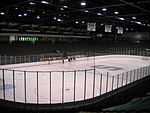Old College Field
1902 establishments in MichiganCollege softball venues in the United StatesDefunct college baseball venues in the United StatesDefunct college soccer venues in the United StatesDefunct soccer venues in the United States ... and 8 more
Event venues established in 1902Michigan State Spartans baseballMichigan State Spartans footballMichigan State Spartans softballMichigan State University campusSoccer venues in MichiganSports venues completed in 1902Sports venues in Lansing, Michigan
Old College Field is an area on the campus of Michigan State University in East Lansing, Michigan. The school broke ground in 1900 to provide a place for the varsity baseball team to play. Today, the area includes facilities for baseball, soccer, and softball. It is located on a floodplain on the inside of a bend in the Red Cedar River. The "New Life for Old College Field" campaign, which began in 2006, was to enhance the sports programs which played on the Field.
Excerpt from the Wikipedia article Old College Field (License: CC BY-SA 3.0, Authors).Old College Field
Beal Street, East Lansing
Geographical coordinates (GPS) Address Nearby Places Show on map
Geographical coordinates (GPS)
| Latitude | Longitude |
|---|---|
| N 42.732444444444 ° | E -84.489833333333 ° |
Address
Beal Street
48825 East Lansing
Michigan, United States
Open on Google Maps











